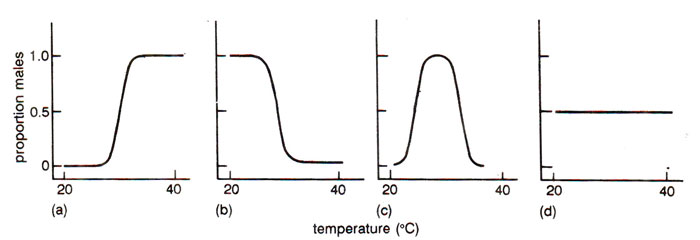Although in majority of dioecious vertebrates and plant species, sex is determined genetically, in many reptiles and in some other taxa, sex is determined by environmental factors such, as temperature. This
environmental sex determination (ESD), as against the
genotypic sex determination (GSD) discussed earlier in this section, has been shown to have adaptive significance.
In most
turtle species only females are produced at high temperature (30-35°C) and only males are produced at low temperature (23-28°C). The sex ratio changes abruptly from all male to all female over just 2°C change in temperature. The reverse is true in many
crocodilians (crocodiles and alligators) and some
lizards (in other species of lizards and probably in all snakes, sex is genetically controlled), where males are produced at high temperature and females are produced at low temperature. In
snapping turtles and in some other turtles, as well as in Australian crocodile, females are produced both at high (30-35°C) and low (25°C) temperatures, but males are produced at intermediate temperatures (Fig. 17.23).

Fig. 17.23. Four different patterns of response of sex ratio to incubation temperature among reptile species; these schematic curves represent the approximate form of response and do not represent the actual data for any one species (see text for details).
High temperature leads to faster growth, shorter incubation periods, larger juvenile size and hence larger adult size. Therefore, as an adaptation, it has been observed that the sex, which develops at high temperature is larger in body size, exhibiting sexual dimorphism. For instance, in most turtle species, females are bigger in size and at high temperature, mainly females are produced. On the other hand, in crocodilians and in some lizards, males are bigger and they are the ones produced at high temperature. The individuals, where females are produced both at high and low temperatures and males are produced at intermediate temperature, are related to turtles (where at high temperature, females are produced), but their eggs face wide and unpredictable range of temperatures (either due to wide geographical range or. due to a large temperature gradient in the nest). Under these circumstances, the above pattern will ensure a reasonable proportion of females in all environments.





